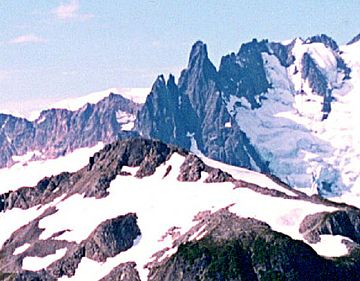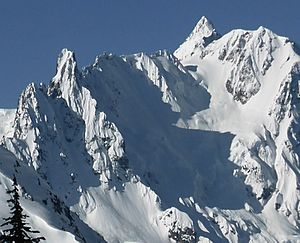Nooksack Tower facts for kids
Quick facts for kids Nooksack Tower |
|
|---|---|

Nooksack Tower from Hannegan Peak
|
|
| Highest point | |
| Elevation | 8,285 ft (2,525 m) |
| Prominence | 325 ft (99 m) |
| Geography | |
| Location | Whatcom County, Washington, U.S. |
| Parent range | Cascade Range |
| Topo map | USGS Mount Shuksan |
| Climbing | |
| First ascent | 1946 Fred Beckey |
| Easiest route | class 4-5.4 |
Nooksack Tower is a tall mountain peak in North Cascades National Park in Washington, USA. It stands about 8,285 feet (2,525 meters) high. This impressive tower is part of the larger Mount Shuksan mountain group. It is located about 0.75 miles (1.2 kilometers) northeast of Shuksan's main peak.
Nooksack Tower looks out over Nooksack Cirque to the west. Glaciers surround it, including the East Nooksack Glacier to the southeast, the West Nooksack Glacier to the east, and Price Glacier to the north. Climbing Nooksack Tower is very difficult. It has loose rocks, very steep slopes (more than 50 degrees), and icy ridges. Getting to the tower is also hard, and climbers often need to rappel (slide down ropes) ten or more times to get back down.
Understanding the Climate Around Nooksack Tower
Nooksack Tower is in a "marine west coast" climate zone. This means it gets a lot of moisture from the Pacific Ocean. Most weather fronts, which bring changes in weather, come from the Pacific Ocean. They then move northeast towards the Cascade Mountains.
When these weather fronts reach the North Cascades, the mountains force the air upward. This causes the air to cool and drop its moisture as rain or snowfall. Because of this, the western side of the North Cascades gets a lot of precipitation, especially snow in winter.
The climate here is mild due to the ocean's influence. Temperatures rarely go below 0°F (–18°C) or above 80°F (27°C). Winters are usually cloudy, but summers often have clear skies. The snow tends to be wet and heavy, which can lead to a high risk of avalanches.
Exploring the Geology of the North Cascades
The North Cascades mountains have very rugged and dramatic shapes. You can see sharp peaks, tall spires, long ridges, and deep valleys carved by glaciers. The story of how the Cascade Mountains formed began millions of years ago.
About 50 million years ago, small pieces of the Earth's crust, called terranes, came together. These pieces, from both the ocean floor and continents, helped create the North Cascades.
During the Pleistocene period, which started over two million years ago, glaciers repeatedly moved across the land. As they advanced and retreated, they scraped away rock and left behind debris. This repeated movement created the "U"-shaped valleys you see today. The combination of the land being pushed up (called uplift) and cracks in the Earth's crust (called faulting) along with glaciation, has shaped the tall peaks and deep valleys of the North Cascades.
Images for kids




